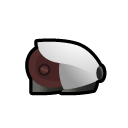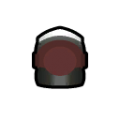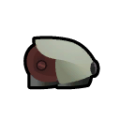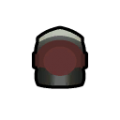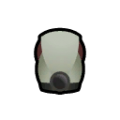Difference between revisions of "Cleansweeper"
| Line 42: | Line 42: | ||
{{Mechanoid Summary}} | {{Mechanoid Summary}} | ||
| − | Dead cleansweepers may be shredded at the [[machining table]] or [[crafting spot]] for | + | Dead cleansweepers may be shredded at the [[machining table]] or [[crafting spot]] for {{Icon Small|Steel||10}} [[steel]]. However, these values are affected by [[Mechanoid Shredding Efficiency|mechanoid shredding efficiency]], as well as missing parts on the cleansweeper. |
=== Combat === | === Combat === | ||
Revision as of 12:49, 26 January 2024
| This article relates to content added by Biotech (DLC). Please note that it will not be present without the DLC enabled. |
Cleansweeper
A light mechanoid designed for cleaning. Lacking a ranged weapon, it can make only weak melee attacks.
Base Stats
- Type
- Mechanoid
- Flammability
- 0%
Armor
- Armor - Sharp
- 20%
- Armor - Blunt
- 10%
- Armor - Heat
- 200%
Pawn Stats
- Move Speed
- 3.4 c/s
- Body Size
- 0.3
- Mass
- 18 kg
- Pack Capacity
- 10.5 kg
- Carrying Capacity
- 23 kg
- Filth Rate
- 1
- Comfortable Temp Range
- -100 °C – 250 °C (-148 °F – 482 °F)
Melee Combat
- Attack
- Head
6 dmg (Blunt)
9 % AP
2.6 second cooldown - Average DPS
- 1.43
Creation
- Required Research
- Basic mechtech
- Gestation Cycles
- 1
A cleansweeper is a mechanoid added by the Biotech DLC.
Acquisition
Cleansweepers can be gestated by a mechanitor at a Mech gestator once the Basic mechtech research project has been completed. They require ![]() 50 Steel,
50 Steel, ![]() 1 Basic subcore and 1 gestation cycle taking 1,800 ticks (30 secs) each to initiate. They take up bandwidth from their linked mechanitor.
1 Basic subcore and 1 gestation cycle taking 1,800 ticks (30 secs) each to initiate. They take up bandwidth from their linked mechanitor.
Dead, friendly cleansweepers can also be resurrected at the mech gestator using the "Resurrect light mechanoid" bill. This requires the corpse of the friendly Cleansweeper, ![]() 25 steel, and 1 gestation cycle taking 1,800 ticks (30 secs) to initiate.
25 steel, and 1 gestation cycle taking 1,800 ticks (30 secs) to initiate.
Summary
| This section is a stub. You can help RimWorld Wiki by expanding it. Reason: Shred yield?. |
As mechanoids, every cleansweeper is immune to fire, Flame and Heat damage, and temperature extremes, despite having Comfortable Temperatures defined. They have 100% Toxic Resistance and Toxic Environment Resistance, making them immune to toxic buildup, rot stink and other toxic effects. They do not need to eat, rest, and have no mood. They will be stunned by EMP attacks for a time proportional to the EMP damage inflicted and will "adapt" and rendered immune to further EMP strikes for 2,200 ticks (36.67 secs).
Dead cleansweepers may be shredded at the machining table or crafting spot for ![]() 10 steel. However, these values are affected by mechanoid shredding efficiency, as well as missing parts on the cleansweeper.
10 steel. However, these values are affected by mechanoid shredding efficiency, as well as missing parts on the cleansweeper.
Combat
Cleansweepers can only make melee attacks. They have a melee hit chance of 62%, equivalent to a pawn with a Melee skill of 4.
As a labor-focused mech, cleansweepers are never found in mechanoid raids.
As an ally
Mechs under player control require power: cleansweepers use 10% of their power per day while active. If set to dormant self-charging, they instead recharge for +1% power / day, without pollution. They recharge in a mech recharger (constant 200W), for 50% power/day, creating 5 wastepacks whenever the recharger's waste is filled up.
Work
Cleansweepers clean, at 50% of a base human's speed. They can't be manually controlled, except when drafted for combat. Like other pawns, they can only clean in the designated home area. They also move slower than a human, at 3.4 cells/s.
Analysis
Cleansweepers do one thing well, and that is to neaten out your colony. Dirt is ugly to look at, and will lower a room's impressiveness. As impressive rooms directly help a colonist's mood, a dedicated cleaner really helps with making your pawns happy. In addition, dirty cooking areas can cause food poisoning, and treating wounds in a dirty room makes infection more likely. It is quite cheap, too, once you get the infastructure - one cleansweeper is all you really need for a small to medium sized base.
You may want to utilize zones to control where the cleansweeper cleans, forcing them to only clean high-importance areas (such as kitchens or hospitals), or limiting access to low-value areas (such as barns or hallways filled with spike traps). If multiple cleansweepers are used, it is generally not advisable to separate each cleansweeper into its own individual zones as this will allow rooms to get dirty while they're charging. Instead, at least two should overlap each area to ensure at least one mech is active and to prevent wasting uptime when one area is clean and the other is not. This is most important in rooms such as hospitals and kitchens where even short spikes in filth can cause significant issues. For other rooms, average cleanliness is an acceptable goal.
Consider installing a mech booster in areas likely to see high areas of filth, to improve how quickly cleansweepers are able to function. Kitchens and hospitals make good candidate locations. Mech boosters will also help any fabricors and paramedics that work in these areas.
Compared to humans
A cleaner robot serves to take place of a human.
If you have an excess of human labor, then the mech might be redundant. However, this could also mean you haven't assigned enough tasks. Conversely, a mech is most valuable when colonists are in short supply, such as in The Mechanitor start. Cleaners also have the advantage of working longer, and not being impacted by mood itself - it won't be bothered by corpses, for example.
An extra hand is also helpful after combat. If many of your colonists are injured, then there'll be many stacks of blood. Blood is dirty, lowering medical chances, and hurts colonist mood because it's ugly. In these situations, you likely won't have the manpower to clean everything up. Thus, cleansweepers can prevent mood and mental break spirals after a particularly damaging raid
Health
Specify body type when known.
Gallery
Version history
- Biotech DLC Release - Added.
- 1.4.3534 - Cleansweepers are now basic mechs: Research requirement changed from Standard mechtech - > Basic mechtech. Recipe changed from
 1 +
1 +  100 ->
100 ->  1 +
1 +  50
50
